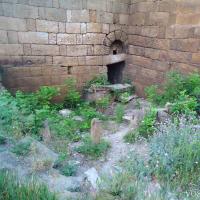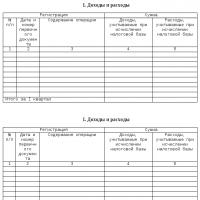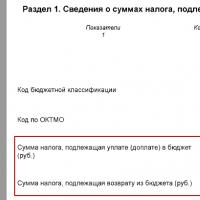Topic: flowers. Lesson on speech development in the preparatory group based on M.M. Prishvin’s story “The Golden Meadow” (lexical topic “Flowers”) Lexical topic plants garden flowers preg group
Lexical topic “Flowers of the meadow”
Children need to know.
Nouns: names of wildflowers (violet, bell, poppy, chamomile, buttercup, porridge, clover, forget-me-not, cornflower), meadow, field, clearing, aroma, stem, leaf, bud, wreath, bouquet.
Adjectives: fragrant, beautiful, delicate, fragrant, fresh, scarlet, purple, snow-white, blue, pink, rare, fragile.
Verbs: tear, cut, collect, sniff, weave, destroy,
protect, protect, pollinate.
Play with the children.
"Give me a word"
We carried mushrooms in a basket
And another blue flower.
This little blue flower
It was called... (cornflower).
The field seems to be covered in yellow waves.
A flower grows here... (sunflower).
Turns deftly
He's behind the sun's head.
We will weave wreaths in the summer
For Oksana, Masha, Sveta,
For Alenka, two Natashas.
All wreaths are made of... (daisies).
Here is a clearing, all in flowers,
Like light blue dots.
I’ll collect it here for Anyutka
Blue forget-me-nots).
"Flower Meadow"
(formation of relative adjectives).
A clearing where daisies grow (what kind?) chamomile.
A clearing where cornflowers grow (which one?) ...
A clearing where bluebells grow (which one?) ...
A clearing where dandelions grow (which one?) ...
"Bouquet"
(noun agreement with numeral)
Dasha decided to collect a bouquet for her grandmother in the meadow. The bouquet turned out beautiful and lush. It contained: three... (cornflower), five... (daisies), four... (forget-me-nots), two...
(poppy) and seven... (bells).
Text for retelling.
FLOWER LOVER
In spring everyone is happy about flowers. Over the long winter, my eyes yearned for bright and colorful things. The guys are picking flowers in the forest. Butterflies, bees and flies rush to the first flowers. And the hazel grouse is there too: it blooms on the willow, blueberries and blueberries - it belongs to them. When the forget-me-nots bloom, neither will the forget-me-nots.
The guys make bouquets of flowers; the bouquets are tender, beautiful, fragrant. Butterflies and bees feast on flowers. Flowers for them are painted self-assembled tablecloths. Sit down and have fun: both honey and
nectar, and juice. And the hazel grouse eats flowers! It turns out that they are also delicious! And she loves forget-me-nots very much. They probably have a special, unforgettable taste.
Everyone loves flowers. Only each in his own way.
N.Sladkoe
Questions about what you read:
Why is everyone happy about flowers in spring?
What are the guys doing in the forest?
Who is in a hurry to see the first flowers?
What do flower guys make?
What do bees and butterflies eat on flowers?
What flowers does hazel grouse like?
Poem for reading and learning by heart.
CORNFLOWER
How clean the rye is on the collective farm -
You can hardly find cornflower.
If only you, flower, would be good for everyone,
But why are you spoiling the rye?
Better come to the garden,
You'll make the guys happy!
E. Serova
Lesson on speech development preparatory group
Topic: The story “The Golden Meadow” by M.M. Prishvin
(lexical topic: "Flowers")
Target:
Teach children a coherent retelling of the story “The Golden Meadow” by M.M. Prishvin, based on graphic diagrams depicting the sequence of events.
Tasks:
correctional and educational:
Clarify and activate the dictionary on the lexical topic: “Flowers”:
Teach children to select relative adjectives to nouns;
Learn a new tongue twister;
Strengthen children’s ability to form new words by adding words;
Teach children to draw up a graphic plan together with their students.
correctional and developmental:
Develop mental processes: attention, memory, thinking;
Develop speech hearing;
Teach children precise coordination of speech and movement;
Develop fine motor skills hands
correctional and educational:
To foster patriotic feelings in children: to cultivate a sense of love for nature, for their native land.
Equipment:
Subject pictures “Flowers”, subject picture “Meadow”, pictures “Dandelion” for reflection, diagram for retelling, markers, magnetic board.
Progress of the lesson:
Organizing time: Finger gymnastics .
We've got our hands ready, let's remember our fun finger exercises:
As soon as the sun rises -
Our flower will bloom.
Cabbage Butterfly
It will fall on the flower.
Look - and the flower
Two more petals.
( Alternately connecting the fingertips of both hands (little finger with little finger, ring finger with ring finger, etc.) for each stressed syllable. Palms do not touch each other)
Today we will talk about flowers, they grow everywhere:
If they grow in a garden, then they are called...garden.
If in the meadow - ... meadow.
If in the forest - ... forest ones.
If in the field - ...field.
If the room is...room.
If in the water - ... aquatic.
If in the mountains -...mountainous.
If flowers are needed for medicine - ... medicinal.
But why are they all called all flowers?
All colors have:
Root, stem, leaves, bud, petals.
All flowers have different names:
Snowdrop - grows under the snow;
Forget-me-nots - do not forget them;
Celandine - cleanses the body;
Plantain - grows by the road;
Marigolds – similar to fingernails;
Yarrow - this flower has a thousand leaves;
Lungwort - a flower that bears honey;
Coltsfoot - the leaves are soft on one side, like mother,
On the other hand - a hard leaf, like a stepmother.
Dandelion – it can be blown away.
Now we will learn a pure saying:
On a green fragile leg
The ball grew near the path.
What flower is this pure talk about?
That's right, about the dandelion. How did you guess? - that's right, ball.
A very interesting flower. This flower grows everywhere - in vegetable gardens and orchards, in meadows and fields.
Now I will read to you an interesting and very curious story by Mikhail Mikhailovich Prishvin “Golden Meadow”.
Why do you think the meadow is golden?
Golden Meadow
My brother and I always had fun with them when dandelions ripened. It used to be that we would go somewhere on our business - he was ahead, I was at the heel.
“Seryozha!” - I’ll call him in a businesslike manner. He will look back, and I will blow a dandelion right in his face. For this, he begins to watch for me and, like a gape, he also makes a fuss. And so we picked these uninteresting flowers just for fun. But once I managed to make a discovery.
We lived in a village, in front of our window there was a meadow, all golden with many blooming dandelions. It was very beautiful. Everyone said: “Very beautiful! The meadow is golden.”
One day I got up early to fish and noticed that the meadow was not golden, but green. When I returned home around noon, the meadow was again all golden. I began to observe. By evening the meadow turned green again. Then I went and found a dandelion, and it turned out that he squeezed his petals, as if your fingers on the side of your palm were yellow and, clenching into a fist, we would close the yellow one. In the morning, when the sun rose, I saw the dandelions opening their palms, and this made the meadow turn golden again.
Since then, dandelion has become one of the most interesting flowers for us, because dandelions went to bed with us children and got up with us.
Conversation on the content of the story:
Now let me know if you listened carefully to the story?
???
Who wrote the story?
What's the name of the story?
What flower did Mikhail Mikhailovich Prishvin write about?
For what fun did the boys pick flowers?
Where did the guys live?
Why did they say about the meadow that was in front of the window: “The meadow is golden!”?
What was in the meadow?
And during the day, why did the meadow turn golden?
What did the meadow look like again like a fan?
What did the writer compare dandelion petals to?
Why did dandelion become the most popular after this incident? interesting flower?
8. Physical minute:
1) Song"Dandelion" N. Nishcheva, L. Gavrisheva
Like a balloon on a leg , stand on tiptoes with hands clasped above head
Dandelion by the path . tilts right - left
Dandelion is a white ball. rise on their toes
I blew and he flew away . children blow with rounded lips without puffing out their cheeks
2) Let’s show the poem with our hands:
Bright yellow dandelion! Hands up like flowers
Why did you change your caftan? threaten
He was handsome, young, hands on hips, “show off”
Became like grandfather, gray ? clasp your hands above your head
Vocabulary work.
Let's find as many words as possible about dandelion.
DANDELION (which?) – interesting, beautiful, golden, green, yellow, fluffy, airy, forest, curious, ...
And if hemany years grows - perennial
Dandelions bloom inMay - May flowers.
Bees love dandelion very much, they are from itcarry honey - honey plant.
Dandelion honey - dandelion honey – thick and aromatic.
Dandelion fluff – dandelion fluff.
10.Sometimes dandelions are compared to a clock, calling them “flower clocks.”
In the morning, dandelions open at 5-6 o'clock in the morning, and at 2-3 o'clock in the afternoon they already close their petals and the yellow lights go out. That is why dandelions are called “flower clocks”.
11. Repeated reading and building a graphic plan with children.
Plan:
1. Fun. (drawing of dandelions with a white cap)
2. The house in front of it is a “golden” meadow (you can circle yellow color)
3. Fishing rod, “green” meadow. (can be a green circle)
4. Sun with rays with the number 12, “golden” meadow (yellow circle)
5. Yellow dandelion - fingers, then fist.
6. Dandelion – pillow – babies.
12. Retelling according to a graphic plan.
You can retell the story individually, in pairs or in a chain.
13. Lesson summary:
1) What was the name of the story by Mikhail Mikhailovich Prishvin?
2) Did you like the story? Why?
3) Reflection.
I am handing out leaves of paper with a dandelion on it. If you liked how you worked in class, then color it green, and if not, then color it red.
1. Look at the pictures with your child. Introduce him to the names of flowers (lily of the valley, coltsfoot, aster, dandelion, bell, chamomile, snowdrop, peony, carnation, daffodil, tulip, iris, gladiolus). Insert the general concept of “flowers” into the dictionary. Note the structural features of the flower: stem, leaves, petals.
2. Connect the flowers (primroses, wildflowers, garden flowers) to the corresponding bouquets with multi-colored lines.


3. Exercise “Call me kindly.” Stem - stalk.
Snowdrop -...
Root -...
Cornflower - ...
Leaf -...
Carnation - ...
Petal -...
Tulip - ...
Flower - ...
Chamomile - ...
4. Exercise “Select, name, remember”: Complete the sentences with action words.
There are flowers in the flower beds (what are they doing?) - growing, blooming, withering...
Flowers from a garden watering can (what are they doing?) - ...
Fertilize garden flowers (what do they do?) - ...
Flowers grown with a knife (what do they do?) - ...
Flowers in bouquets (what do they do?) - ...
People with flowers (what are they doing?) - ...
5. Tell your child that not all flowers can be picked. Some flowers (snowdrop, lily of the valley, lungwort) are listed in the Red Book. They need protection.
6. A bouquet of flowers is a wonderful gift for any occasion. Exercise “Bouquet for Mom.” Vanya and Tanya, walking through the meadow, collected beautiful bouquet for Mom. Color the bouquet and tell what flowers the children used to make it up.
7. Listen to the story. Fill in the missing color names in the sentences.
Birds brought spring on their wings. From the warm rays of the sun, the clearings thawed from the snow, and the first flowers appeared on the thawed patches - primroses:...
Alena Antipina
Speech therapy tasks on the lexical topic “Flowers”
1. What is this? Name it in one word: roses, daisies, cornflowers, tulips...
2. Learn the poem:
Golden and young, he turned gray in a week.
And after two days my head went bald.
I'll hide it in my pocket
Former dandelion.
3. Guess the riddles:
The head is on a leg, there are polka dots in the head.
The sun is burning the top of his head, he wants to make a rattle (poppy)
I was walking along a path through a meadow and saw the sun on a blade of grass.
But the sun's white rays (daisies) are not at all hot
The rye is earing in the field, there you will find a flower in the rye.
Bright blue and fluffy, it’s just a pity that it’s not fragrant (cornflower)
4. Name the parts of a flower: (stem, leaves, bud, roots)
5. Name:
1st sound in the word roots
2nd sound in the word leaves
3rd sound in the word stem
4th sound in the word bud
6. Divide the words into syllables: flowers, cornflowers, gerberas, lily
7. “The fourth wheel” (explain why)
8. “Developing fingers” (development of fine motor skills)
A tall flower has grown in a clearing (palms clasped in front of us, arms raised up).
On a spring morning I opened the petals (spread my fingers).
Beauty and nutrition to all petals (movement with fingers).
Together they give roots underground (exercise “Roots”).
9. “One is many” (education plural nouns)
Tulip – tulips
Cornflower -
Gerber –
Chamomile -
10. “Related words” (selection of words with the same root)
Color (flower, little flower, flower garden, flowers, flower girl)
Earth (earthen, strawberry, land)
11. Why do we need flowers, what are the benefits of them? (For medicine, give food to insects, decorate our lives)
12. Name the flowers whose names contain the sounds L, R, Sh
13. Make sentences using words and pictures.
Grandma picked and placed a vase in daisies
Girl, mother, bouquet, gave, tulips
14. Write a descriptive story about daisies, roses, or tulips using the diagram.
15. Write a story - a comparison about flowers: daisies and gerberas (similarities and differences)
Publications on the topic:
Why are home speech therapy assignments needed? One of the most important conditions A child's success in school is based on good preschool preparation. L. S. Vygotsky wrote: “Prepare.
Tasks on the lexical topic “Road Rules” 1. “Make the sentence correctly” Car, drive, road. Airplane, sky, flying, high. Big, waves, ship, floating. Highway, car,.
Lexical topic "Flowers". In March our children speech therapy group studied the lexical topic "Flowers". We talked with the children about which ones.
 Goals: EDUCATIONAL: Expand and consolidate children’s knowledge about spring flowers, introduce the general concept of “flowers” into children’s active vocabulary.
Goals: EDUCATIONAL: Expand and consolidate children’s knowledge about spring flowers, introduce the general concept of “flowers” into children’s active vocabulary.
Lesson notes to consolidate the lexical topic “Flowers” Goal: creating conditions for the development of the lexical-grammatical structure of speech and coherent speech when implementing the content of the lexical topic “Flowers”.
Lesson notes on the lexical topic “Transport” Lexical topic: “Transport” Goals: Correctional and educational: - Create conditions for development verbal communication children with adults.
Practical assignments for the seminar Topic: Development of phonemic hearing, sound and intonation culture. Task No. 1 Read the text and...
We are studying on the topic: "Garden and wildflowers"
Children should know:
· the name of garden and wildflowers, be able to classify them (field - cornflower, dandelion, lily of the valley, etc.; garden - rose, tulip, etc.);
What parts do flowers consist of?
How do you care for garden flowers?
What is the difference between wildflowers and garden flowers?
· medicinal properties some colors.
Vocabulary
The child's vocabulary should include:
Nouns: primrose, snowdrop, dandelion, coltsfoot, daffodil, tulip, bell, cornflower, lily of the valley, rose, peony, lily, carnation, calendula, aster, chamomile, buttercup, forget-me-not, violet, bud, petal, stem, leaves, thorns, nature, security, etc.
Adjectives: beautiful, delicate, fragrant, scarlet, lilac, snow-white, golden, pink, blue, rare, fragile, fluffy, smooth, curly, indoor, meadow, garden, medicinal, carved, fragrant, bright yellow, field, light-loving, heat-loving.
Verbs: grow, bloom, grow, plant, plant, water, care for, loosen, replant, water, sow, smell, cut, admire, tear, wither, collect, destroy, smell, draw, bloom, bloom, etc.
Grammatical structure of speech
1. Game exercise"Count" (coordination of numerals with nouns with numbers 1,2,5).
One beautiful flower, two beautiful flower, five beautiful flowers
One forest violet, two forest violets, five forest violets
(pink peony, prickly rose, white chamomile, fragrant lily of the valley, blooming aster, blue bell, delicate petal)
2. Game “Which one?” Which? Which?"(noun agreement with
adjectives)
Snowdrop(which one?) – the first, white, tender...
Violet(which one?) – small, purple, fragrant, forest...
Leaves(which ones?) - green, delicate, oval, carved….
(chamomile, dandelions, peony, flower bed, lilies, cornflower)
3. Game exercise “Flower meadow”(formation of relative adjectives)
The clearing where daisies grow (what kind?) is chamomile.
The clearing where cornflowers grow (which one?) is cornflower.
The clearing in which flowers grow (what kind?) is floral.
The clearing where dandelions grow (what kind?) is a dandelion field.
4. Game exercise “Select, name, remember”(selection of verbs to nouns)
Flowers in the flower beds(what are they doing?) – grow, bloom, wither, bloom….
Flowers from a garden watering can(what are they doing?) - ……
Fertilizers for garden flowers(what are they doing?) – ……..
Growing flowers with a knife(what are they doing?) -…….
Flowers in bouquets(what are they doing?) .....
People with flowers(what are they doing?) - …….
Connected speech
1. Exercise “Tell me”:Compose a story about flowers according to the proposed visual plan.

Development of attention, memory, thinking
Exercise “Help Dunno”(to train children in using prepositions in speech)
· A motley butterfly is spinning…. yellow dandelion.
· Hardworking bees collect nectar... from flowers.
· A bouquet of flowers costs…. beautiful vase.
· …. An ant hid in a dandelion leaf.
· The butterfly flew up to... a bluebell, then sat down... to a clover, collected pollen.... daisies.
· The aroma of lilies of the valley attracts... insects.
· In spring… the first flowers appear in the snow.
 About the origin of the self-name of the Dargins - History and geography - My Dagestan - Dargo's Path
About the origin of the self-name of the Dargins - History and geography - My Dagestan - Dargo's Path With changes and additions from Section II
With changes and additions from Section II An example of filling out section 2 3 of personal income tax
An example of filling out section 2 3 of personal income tax See what “1960s” is in other dictionaries 60s of the 20th century in the USSR
See what “1960s” is in other dictionaries 60s of the 20th century in the USSR Folk remedies for nausea
Folk remedies for nausea Reading the twelve gospels on Maundy Thursday Reading the 12 gospels of the holy passion of our Lord Jesus Christ
Reading the twelve gospels on Maundy Thursday Reading the 12 gospels of the holy passion of our Lord Jesus Christ Clapeyron–Clausius equation
Clapeyron–Clausius equation